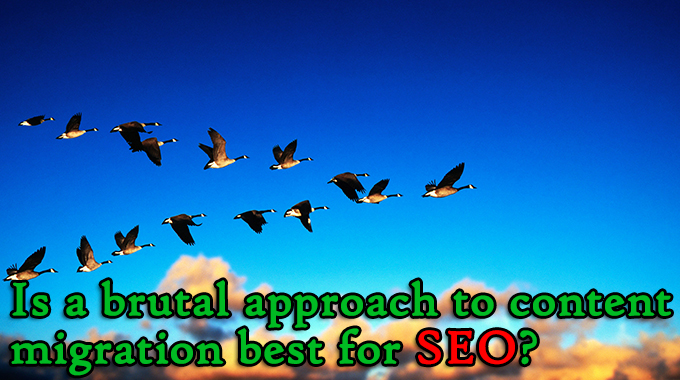Is a brutal approach to content migration best for SEO?

I read a great article over at Boagworld about the pain of content migration, a term that will send shivers down the spine of anybody unfortunate enough to have been through such a process.
Written by Paul Boag, it explains some of the common problems with migrating vast amounts of content. Notably, the reorganising of content in a way where lots of mismatches occur, breaking navigation and links, ending up with wonky URL structures and – as a result – lots of frustrated users and too many 404 pages being shown.
Paul suggests that you need to tackle the issue head on, by pruning your website.
“Failing to address content in a redesign means that your shiny new website inherits the problems from your old one. You will have a bloated website full of redundant, out of date or trivial content. Content that you should be removing.”
He says that a redesign is the best opportunity you’ll have to remove content, and he’s right. Content owners and other stakeholders can be very precious about old content. They’re emotionally attached to their work and don’t want to see your grubby fingers hovering over the Delete key.
So what to do? The solution is brutal.
Cut everything
Instead of removing content, maybe the mindset should be about adding content…
“What if you started from scratch? What if instead of deciding what to remove you removed everything? You then don’t have to audit what you already have. Your political fights are less too. After all everybody is receiving equal treatment. Everybody is having their content removed.”
An intriguing thought, and one that is probably backed up by the data.
“Take a moment to look at your analytics. I bet the vast majority of traffic only hits a fraction of your pages. I also bet that if your site is big there is an enormous proportion of pages that are rarely if ever viewed. In truth 80% of your audience only needs 20% of your content. So cut the rest. At least to start with. You can always add content back in later if there is a proven case.”
This is certainly a hardcore approach to a site redesign, but it makes sense. Everybody involved will understand that it’s not just the design that is being overhauled, but the content too. From there it’s about what is added back to the site.
Caution: SEO
While I like this bold approach, and I agree that it’s wise to get everybody on the same page when undertaking these large projects, there are some alarm bells ringing in my head.
Firstly, let’s consider SEO, given that any content-rich site will probably attract the lion’s share of its traffic from organic search, if the team and technology are doing the right things.
Removing so many pages might seem like a good idea if they all have low amounts of traffic, butcontent clustering is important from a Google perspective.
It’s generally a good idea to have a sense of how similarly themed pages contribute to your overall rankings, even if they don’t appear to do much for your business on the face of it.
For example, it might be risky to remove them if they have lots of internal links to related pages, hero pages and hub pages.
Also, some of these pages may rank for the niche terms that contribute greatly to your business, even if the volume isn’t there…
Alert: high value visitors
The data doesn’t lie, does it? No, but it depends on what you’re looking for.
If you axe 80% of pages based on visits or – worse – impressions, then I fear that the axe may swing around in your direction.
Low-traffic pages can attract some of the most interesting visitors, either by accident or design.
Sometimes a page will rank for something so specific, either by way of a highly descriptive anchor text link or on-page content (or more often some combination of the two), that it will attract a very specific type of visitor.
Some of the best conversion rates live in the long tail. If only we could scale it!
Niche content has its place, and the user flows from these landing pages to key conversion areas of your website can be really valuable. Pages that are positioned prominently for high intent, multi-phrase terms should be your bread and butter.
Plan ahead
Finally, it’s crucial to spend some time figuring out taxonomy, metadata and vocabulary upfront when starting afresh with content (or undertaking a migration). It will save you so many headaches down the line, and it will help your techies to make sense of your content, when undertaking a migration.
If a redesign and content migration is looming then you have my sympathies. It’s a stressful time for all involved.
The key to getting it right is all in the planning, before and after you launch. That means a proper audit of your content, your search analytics, and your tech. Good luck!
___
by Chris Lake

